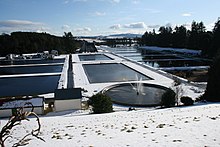Vartry Reservoir
| Vartry Reservoir Taiscumar Fheartraí | |
|---|---|
 Roundwood Lakes | |
| Location | County Wicklow |
| Coordinates | 53°03′31″N 6°12′12″W / 53.05861°N 6.20333°W |
| Type | reservoir |
| Primary inflows | River Vartry |
| Primary outflows | River Vartry |
| Basin countries | Ireland |
Vartry Reservoir (Irish: Taiscumar Fheartraí) is a reservoir at Roundwood in County Wicklow, Ireland. The water is piped from Vartry to a large open service reservoir in Stillorgan in the southern suburbs of Dublin. The reservoir is operated by Dublin City Council.[1]
The original (lower) reservoir was completed in 1863 and has a capacity of 11.3 billion litres and a maximum depth of 18.3 metres. A second embankment, 3.5 km upstream, was completed in 1923 to form the upper reservoir. This has a capacity of 5.6 billion litres and a maximum depth of 13.4 metres.[1]
History


The Vartry Reservoir scheme involved the partial redirection and damming of the Vartry River, the building of a series of water piping and filtering systems (and related public works) to carry freshwater to the city.[2]
Between 1862 and 1868 the lower reservoir was formed by constructing an earthen dam across the valley of the River Vartry after a Dublin Water Works Committee was established to develop a new water supply to Dublin and suburbs.[3] The committee was chaired by Dr. John Gray who actively promoted what would become the "Vartry scheme".[4] The scheme was formally opened on June 30, 1863.
This work was particularly important in the improvement of living conditions and public health in Dublin city.[4] It improved sanitation and helped reduce outbreaks of cholera, typhus and other diseases associated with contaminated water.
References
- ^ a b

- ^ ENFO - Ireland's public service department with responsibility for environmental publications - Article on Dublin's Water Supply
- ^ Norwood, John (1872/1973). On the Working of the Sanitary Laws in Dublin, with Suggestions for their Amendment. Vol. VI, Part XLIII. Dublin: Journal of the Statistical and Social Inquiry Society of Ireland. pp. 230–242.
{{cite book}}: Check date values in:|year=(help) [1] [2] - ^ a b "Glasnevin-Cemetery.ie - Entry on Sir John Gray". Archived from the original on 2007-11-18. Retrieved 2008-08-01.

